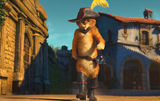
Head of Lighting for ‘Puss in Boots’, Mark Fattibene describes his team’s work on the movie, and shares insights into DreamWorks’ research on lighting stereo 3D projects and recent changes to their lighting pipeline.
 |
|
| The lighting team for ‘Puss in Boots’ was relatively large, working alongside the production designer Guillaume Aretos and VFX supervisor Ken Bielenberg. Many scenes, such as those set in the small village where Puss and his old friend Humpty Dumpty spent their childhood days, needed a ‘western’ feeling, which often has a monochromatic look. “For the vision the production had for ‘Puss’, the typical sun-bleached environments were going to be a little too monochromatic and wouldn’t cut well with other parts of the film, such as the sequences up the beanstalk at the giant’s castle. So we nudged the colours’ saturation a little higher and introduced more contrast,” said Mark.
Out of Shrek’s World |
|
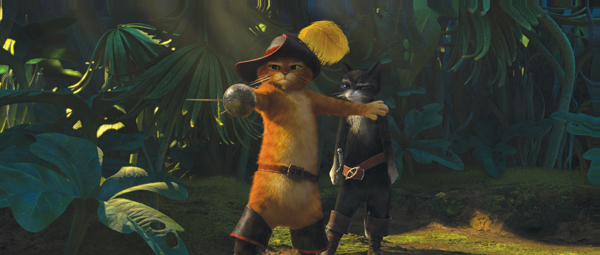 |
|
| The team’s work started with concepts and look development paintings from the art department and production designers, translating these illustrations into the way they would look as moving, lit images occupying space. ‘Puss’ may live in fantasy and fairytales but the lighting had to have a coherent, consistent logic grounded in the physical world, and still encompass all the real world factors. Mark said, “We asked ourselves, ‘How would light move through this kind of room, with this much atmosphere and dust, with candlelight?’ The production designer also set a colour script, giving the artists an idea of what certain colours stand for in the story, that the lighting team used to inform our light.
“Several scenes during the production are set at night or in dark places, and a balance had to be achieved between realistic darkness and a recognisable, interesting look. Looking back at DreamWorks’ projects over time, I think we have become much more comfortable with both letting light recede into darkness and pulling the saturation out of objects. It remains a constant challenge to maintain that balance between depth and colour.” |
|
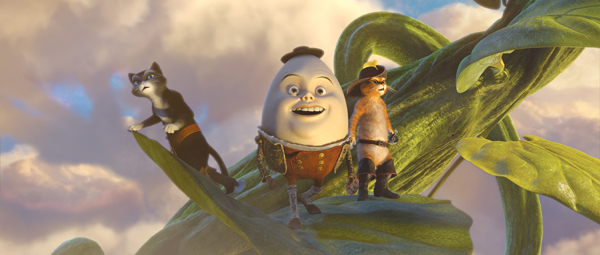 |
|
| Naturally Unnatural Overall, lighting remained naturalistic for ‘Puss in Boots’, but at times the artists would use non-complimentary colours in areas of shadow, putting slightly discordant colours together to convey an edgier feeling, or putting certain colours into unexpected places. “In the thieves’ bar, for example, we were using green to express Puss’ uneasiness – as light receded into the background it doesn’t turn to a natural looking colour but to a greenish tone. Using green for interiors, away from an outdoor setting, tends to look unnatural,” Mark explained. “The very dynamic sequence when the beanstalk is growing with the characters on board, climbing higher and higher, the sky darkening overhead as they leave the atmosphere, caused challenges due to its organically growing shapes. Lighting models for objects like plants are not simple or just a matter of diffuse shading, or diffuse and specular. They require many layers of subsurface light plus components of diffuse specular reflectivity.” Another challenge was the changing lighting conditions. The stalk goes through four or five different scenarios, based first on bright sunlight, then the aurora borealis, a rainy section and a cool night sky, eventually arriving at the castle. “To give the sequence focus, we concentrated on making the characters look right in each scenario and making the beanstalk follow suit. In this sequence it virtually takes the role of a character in itself. But lighting characters has to be primary. It was a tricky sequence. For fun, we tried watching it in our theatre at DreamWorks with our stereo glasses on, standing on one leg to see if we could stay standing up. It wasn’t easy,” said Mark. |
|
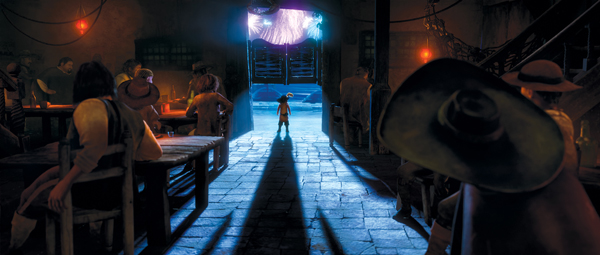 |
|
| Lighting Stereo 3D When Mark was working on DreamWorks’ first stereo project, ‘Monsters vs Aliens’, they first did considerable research into what stereo means for lighting. “Lighting is largely concerned with pulling the eyes where you want them to go. In a flattened 2D image, lighting artists have to resort to an array of tricks to attract viewers’ eyes into a certain area. They might make it brighter or more saturated, or more colourful and contrasty.” “But in stereo we use fewer ‘tricks’ because the eyes can move around the scene more easily and travel back into the depths. As long as the editing is correct and shots are blended together into sequences and scenes so nothing jars the eyes, they will follow the action wherever it is. We could often take advantage of the stereo effect to ramp up the emotional impact of a scene and form a connection with the audience. Some tricks still apply to lighting, to support dramatic point or overcome all the busy distraction within a stereo scene. We also use more atmosphere – haze, fog, god rays – to create a sense of depth.” Humpty Dumpty’s egg shape was interesting to light, more so once he was animated. A sphere is normally straightforward to light but dealing with Humpty’s smooth face on the egg shape required some planning. The design goal for him was to keep the face quite simple to play off of his frilly, embroidered clothes as a contrast to keep attention on his face. The animation helped give the face interesting shapes to catch light like the round cheeks, chin and nose. |
|
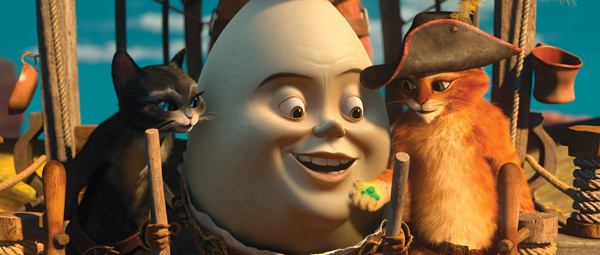 |
|
| At the Back End When working with other departments, lighting is generally referred to as the ‘back end’ of production, closer to the final image. A consumer of the other teams’ work, from modelling to animation to camera to surfacing, the light team has to construct a visually meaningful shot from the other team’s components, going beyond shot composition and balancing of assets. The story is at the front end of the pipeline. Once it has been developed enough, previs serves as the precursor to layout, using streamlined versions of the models to stage the action, compose shots and put the camera in. By representing the storyboards as simple moving images, the director can develop a feeling for the movie and his direction. By the time this is underway, modelling will have been working in parallel, creating characters first, and further artwork continues to be submitted for approval, which in turn determines how surfacing will paint the maps for the models. As soon as a character is complete it will go to rigging to build a skeleton and then to animation. In this way, the paths for looks and performance run in parallel. Because Mark is mainly concerned with looks, he is closely involved with the surfacing and art departments. At the time lighting starts on a sequence, the edit will be about 80 per cent locked. Any further changes would only be to dialogue or camera drift, and once the lighting is in place the colour grade might follow. Character effects happen in the meantime, like cloth and hair simulations, plus special effects such as the ‘tornado’ effect of the growing beanstalk. |
|
 |
|
| Effects Integration The special effects team also built the cloud system and created all of the cloud for the film’s spectacular cloudscapes. “The clouds were delivered to us as rendered elements that we composited with our rendered characters to complete the final images. The departments really don’t work in isolation. Our closest contacts are surfacing and effects, because we all work closer to the final image. Every image needs surfacing of course and, with the effects artists, we usually work together on integration, ownership and delivery of tasks, and how all the resulting layers will go together. Skies created by the matte painters give the lighting its ambient colour and colour for bounce lighting and sky fill. If the skies haven’t been completed, the important factors the lighting artists need are sky colour and gradient. Also, lighting wouldn’t start before the camera work was done, or before the animation was well-defined at least so they know where the action is. Surfacing has to be in place as well, but all of the elements and components are constantly evolving, including light. |
|
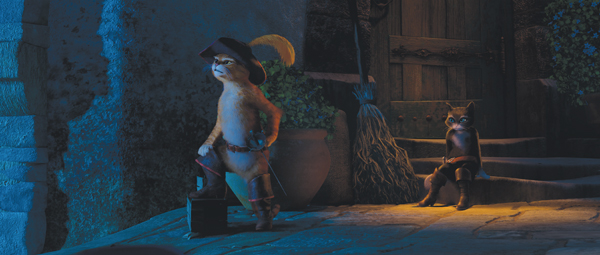 |
|
| Colour Scripting “A lot of our work with upstream departments is a matter of making sure we understand the production schedule, changes being made, and coordinating on the project’s major scenes and assets. For example, much of the movie I’m working on now, called ‘Turbo’, takes place at the Indy 500. When that environment was being modelled, we spent a lot of time planning with the modelling team how we could break it up and make it useable, given the manner in which it would be shot, and work efficiently.” The art department will get a colour script approved to define the feeling of each sequence, initially quite broadly as, for example, a night scene, bright daylight or a ‘golden’ look. Then as the lighting team gets involved with each sequence they make more detailed decisions about atmospherics, how bright it should be and special qualities like ‘magical’. They also look at lots of reference – films, paintings, other CG work – to be able to capture visually whatever the action needs. “What especially helps us is working with the art department to pick out key shots we’ll use to establish our look. The artists paint these scenes as art keys that we either match exactly or match in feeling to achieve the production’s goals. Once the key shots are transferred from 2D paintings into a 3D lit image, perhaps just a frame at first, we can set it in motion. We’ll take that successful lighting into several other shots to see how it makes the whole sequence feel. Then we determine if we’ve directed the viewers’ eyes into the right places, if it expresses the right emotions and lends itself to the story.” |
|
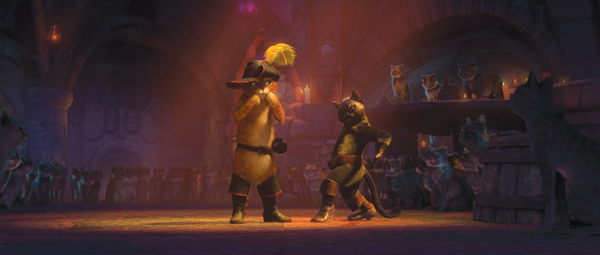 |
|
| Duelling Dancers These steps are carried out according to schedule within a planned ‘lighting set-up time’, before they start to address every single shot. An example of a sequence where these steps were crucial was Puss’ and Kitty Soft Paws’ dancing duel at the beginning of the film. Mark said, “If you look at it, or even just one complex shot, from purely a lighting perspective, you can break down the lighting scenarios that just Puss goes through. A spotlight tracks with him while several other lights bring out small areas in the background, but not so much so that they compete with the cats. They are just fun or humorous details that support the action and need some emphasis. “Also, we always keep an eye on depth. Are we conveying the depth of this space correctly? Stereo can help us but also gives away most of our tricks. Do the candles sitting on the table illuminate the gritty atmosphere around them? Is there enough atmosphere? Even without considering the 30 other cats in the scene or the dancing animation, the lighting complexity required in sequences like this was very high to make the audience feel that they are there, in that space.” |
|
 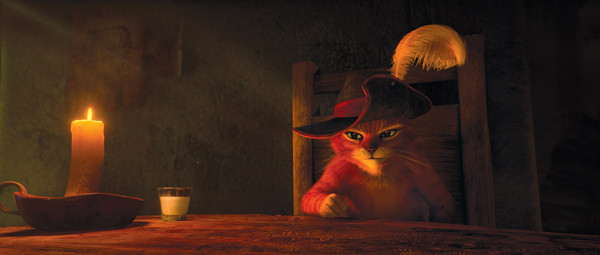 |
|
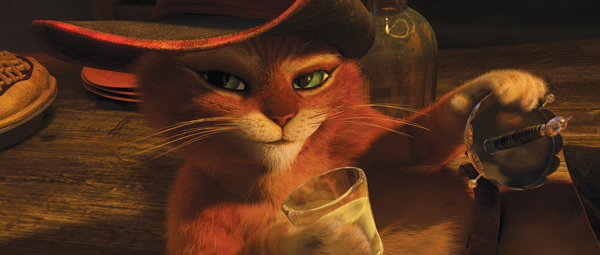 |
|
| Standing Tall The cats were the stars of that sequence and appeared to stand tall. However, at other moments they need to share the environment with humans where they are relatively small, and their size becomes another story point. The thieves’ bar scene, when Puss finds out about the goose, the golden eggs and Jack & Jill, was the first sequence Mark’s team worked on. The director wanted Puss to feel small, so as he walks in the disparity between his height and the height of the thieves is emphasised. Even when he first sits down, he sits quite low into his chair. But as he rallies and takes charge of the situation, he rises a bit higher in the chair, helped by a stereo move that, instead of keeping him back and apart, starts to close that distance between him and the other thieves. The camera staging starts to change. He is more frequently in the foreground while the thieves are shifted into the background, and therefore looks larger. So, dealing with size can be used as a story point and convey a feeling. |
|
 |
|
| Highs and Lows Sequences that Mark particularly liked working on were the emotional ones, such as the flashbacks into Puss’ and Humpty’s childhood, for example. “In these moments we see characters reaching extreme highs and lows and get to know them better,” he said. “They are good opportunities to draw out much more of their character through both animation and light. When Humpty secretly tries to grow magic beans or is thrown into gaol are other revealing moments, plus the dramatic scene when Puss takes his long dive off the bridge after Humpty leads him astray. These scenes are quieter, but sweet and poignant.” Mark feels that 3D animated movies have developed to a state where both the artists and viewers can regard them as film and look for subtle emotive moments in the story. DreamWorks strongly believes in iteration as a means to improve shots. It gives the artists many more chances to change details. Within the schedule, certain goals are set for each step, plus time for iteration, typically done at shot level with time to render – though perhaps not every frame - review and move on. Mark said, “Because the luxury of each department working sequentially is rare, an iteration in lighting may also include the latest surfacing iteration, cloth animation or effects. The most important aspect is understanding the changes made, the data created and how they arrived there, at any point. Keeping track is often mental but if necessary we can access databases for details.” |
|
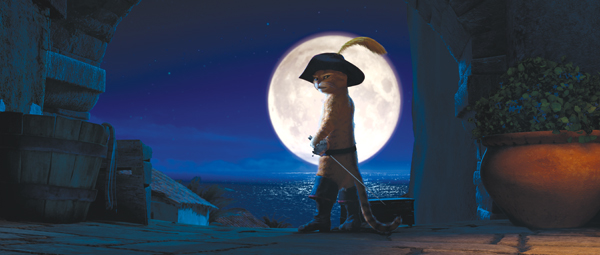 |
|
| Images courtesy of Paramount Pictures | |
| New Generation Toolbox Right at this time, DreamWorks are moving to their own next-generation of tools. Up to now the tools have been relatively proprietary and most of the software we used has been developed there. This is changing. Nuke and Houdini are now in pipelines across production. ‘Puss in Boots’ was the first film on which Nuke was used for compositing, and it worked well for matte paintings, paint fix and effects. Nuke was also helpful to Mark’s department, in some ways allowing them to become the ‘lighting, rendering, compositing department’. Taking this role involved such decisions as ‘Do we light and render a shot, or adjust the existing images, colour correcting and adding blur?’ Nuke gave them more choices in the composite. Its stereo tools, or facility to write custom scripts for stereo, were a great help as well. “The next generation of lighting tools has been in development for some time and is about to be introduced into production,” said Mark. “A further, front end component for animation will be available in another six to eight months. The desire is to take advantage of multithreading capabilities in modern computers. Our machines are larger and faster now with more cores, and Dreamworks wants to use this capacity to iterate more. After so much experience and research into our pipelines and how they need to be configured to make animated movies, we want to use these tools to get there better and faster with more iterations and, hopefully, combine areas of the of the pipeline.” |


















